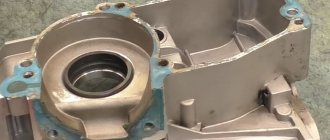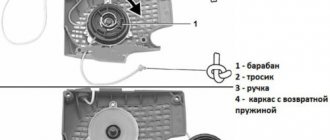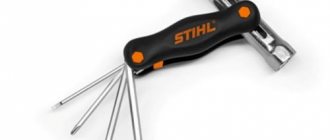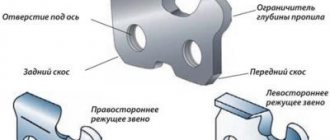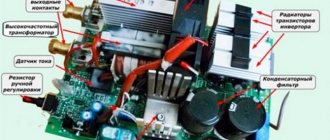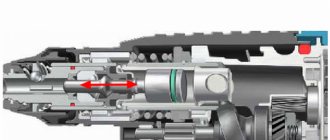A chainsaw is a necessary thing in the home and garden, helping to quickly and efficiently carry out various work with wood. Like any electrical device, it periodically fails and requires diagnostics. The result of the last event is often the conclusion that it is necessary to repair the chainsaw tire - the mechanism that experiences most of the load during operation.
Chainsaw malfunctions and how to repair the tire yourself
A chainsaw is a necessary thing in the home and garden, helping to quickly and efficiently carry out various work with wood. Like any electrical device, it periodically fails and requires diagnostics. The result of the last event is often the conclusion that it is necessary to repair the chainsaw tire - the mechanism that experiences most of the load during operation.
Design and principle of operation
To independently troubleshoot problems, the owner will need a good knowledge of the structure of the chain saw. This is a device powered by a single-cylinder internal combustion engine. Fuel liquid is gasoline. The saw mechanism is driven by a single-stage chain transmission and is covered by a casing for safety.
The main design elements are an air purification system, a chain mechanism, an engine, a tension device, ignition elements, a flywheel and a clutch. Many small parts connect the main components and contribute to the reliable operation of the device.
The properties of the automatic centrifugal clutch depend on the number of revolutions of the power unit. A low rotation speed does not transmit rotation to the drum. Only when a high number of revolutions is reached does the centrifugal force exceed the force of the springs, causing the drum to rotate. The chain and sprocket located in front begin to move.
Malfunctions and how to repair a tire
To repair a chainsaw with your own hands, you will need a detailed diagram and an understanding of the operation of the basic mechanisms of the device. The guide bar and its fasteners are vulnerable, consumable parts that experience the greatest load. You can repair the chainsaw tire yourself or by contacting a service center. Wear and breakage in this area are indicated by the lack of normal tension, sharp or intermittent movement of the chain, the inability to provide normal lubrication and fastening of the cutting axis in relation to the body of the unit. Types of breakdowns:
- The rear and front drive links are riveted. The reason is a mismatch between the pitch of the sprocket and the chain links, weak tension or wear of the sprocket. The problem is solved by replacing or adjusting the mechanisms.
- The presence of broken or broken links indicates weak tension or a broken chain.
- Rounded spout backs occur when the chain set is too long and there is not enough oil.
How to sharpen
Periodic sharpening is a mandatory measure necessary for the normal operation of the gas device. Ways to sharpen your chain yourself:
- Using a file is a simple and common option that allows you to carry out the work directly at the sawing site.
- Use of a special machine. The method is found in private households and service centers.
- With the help of a grinder. Sharpening requires skill.
A special machine is the most effective method. But using a file you can also achieve good results.
Engine malfunctions
- the engine does not start;
- starts but stalls;
- works unstably;
- does not develop power, i.e. It runs fine at idle, but stalls under load.
When repairing a chainsaw with your own hands, you need to act by elimination - inspect alternately all the possible causes of a malfunction, starting with those that take the least time to check and eliminate (see here for information on the design and operation of a two-stroke engine).
Ignition system
. Almost all types of engine problems listed above can be caused by ignition system failures. Therefore, when they occur, it makes sense to start troubleshooting with a spark plug. This is all the more justified since the state of the latter can provide useful information about the operation of the fuel system. So, if a problem occurs, you need to unscrew the spark plug and inspect it.
The wire is disconnected and the spark plug is unscrewed with a special wrench.
If the spark plug is dry, this means that the problem is most likely not in the ignition system, but in the fuel mixture not entering the cylinder. You can wrap the spark plug back and get to work on the fuel system. If the spark plug is heavily splashed with fuel mixture, it means there is an excess of it. This may occur due to carburetor misadjustment or violation of starting rules. The spark plug is wiped and dried, the cylinder is dried by turning off the fuel supply and operating the starter to ventilate the combustion chamber and remove excess fuel. Then install the spark plug in place and repeat the start.
The presence of a large amount of black carbon also indicates a malfunction in the fuel system.
The ratio between oil and gasoline in the mixture may be incorrect, the carburetor may not be adjusted, or low-quality oil may be used. The spark plug is washed in gasoline, cleaned of carbon deposits with a needle or awl, the electrodes are cleaned with fine sandpaper and replaced.
In all these cases, it would be a good idea to check the gap between the spark plug electrodes. Depending on its brand, it should be in the range of 0.5-0.65 mm. You also need to check the spark plug seal. If it is worn out or damaged, the tightness of the combustion chamber may not be ensured, which leads to a decrease in compression in the cylinder and problems in engine operation.
Even if, when checking the spark plug, there is good reason to believe that the fault is in the fuel system, you need to check the spark plug for the presence of a spark. At least to be sure that everything is in order. For this:
- put the ignition cable on the spark plug;
- using pliers with insulated handles, apply the thread or nut of the spark plug to the cylinder;
- pull the starter handle and see whether there is a spark or not.
If there is no spark, you just need to replace the spark plug. If the new spark plug does not have a spark, you need to check the condition of the high-voltage wire for a break and contact with the spark plug.
Source nzizn.ru
A chainsaw is a simple device that, with proper care, can last a long time. At the same time, the saw is a tool subject to various loads and, therefore, breakdowns still occur. You will learn about what caused a certain malfunction and how to fix it from this article.
How to choose a tire
Choosing a tire is a responsible event, the result of which depends on the operation of the entire device. Installing an unsuitable element not only leads to failure of other parts, but is also unsafe for the operator. In order to correctly select a component, you will need data on the length, size, shape and parameters of the shank.
The size is determined by the types of work you plan to do with the saw. Small dimensions are suitable for simple manipulations and cutting thin boards. The most powerful installations are useful for harvesting firewood from thick tree trunks.
How to install a bar on a chainsaw
Before removing the tire, it is recommended to check that the necessary components and tools are available. Tire installation starts with the quick chain tension system, then moves on to the side and front devices. Following the sequence will allow you to correctly assemble the mechanism and ensure productive operation of the tool.
Foundations
Don’t know how to disassemble a Partner chainsaw? After cleaning the compressor, follow the basic algorithm:
- Disassembling the brake chain cover;
- Disassembling the pollen kit;
- Removing the top cover;
- Remove the handle of the device;
- Starting analysis.
This is the first step, and it is recommended that you follow this up by re-cleaning (again with the compressor) the ductwork, which may contain pieces of wood dust that you did not get rid of during the first cleaning.
- Air filter housing;
- Carburetor.
Practical tips for repairing a chainsaw tire yourself
A chainsaw is a very useful thing on the farm. After all, it quickly and relatively easily solves a lot of problems in home construction, gardening and landscaping. Chainsaws are a rather capricious tool, but when handled correctly they are an indispensable assistant. Which has one weak point: the guide rail. It bears most of the operational loads. This means that knowledge of why tires fail more often than other parts of chainsaws and how to properly replace them if necessary will again and again help you save money and time during seasonal or project work with the tool.
Malfunction of unspecified category
In some cases, owners of chainsaws have to solve more complex problems to fully restore the functionality of their cutting tool.
The chainsaw does not develop full power
In addition to the problem discussed above with a lack of gasoline or air entering the cylinder, the cause of low power may be a clogged muffler.
If you do not periodically clean the muffler clogged with combustion products, then the problem of poor engine power may not be the only one.
Carburetor depressurization and nozzle blockage
Over time, the screws holding the carburetor cover in place can become loose or the gaskets can become unusable. A clogged filter or improper replacement can lead to clogged injectors. All this also negatively affects the operation of the chainsaw and shortens its service life.
To prevent this, it is enough to periodically inspect the saw and, if necessary, evenly tighten the screws.
Chainsaw won't idle
It often happens that after long-term transportation and constant use, a chainsaw refuses to idle smoothly. As a rule, this problem is eliminated by adjusting the carburetor.
You can learn how to properly debug the carburetor from this video:
If the carburetor is tuned like a clock, then you need to check:
- Fuel system. It makes more sense to start with the fuel pump.
- Muffler. There is a high probability that due to the abundance of accumulated soot, the engine cannot function normally.
Chainsaw loses power under load
If during operation the power of the saw disappears somewhere, then the problem should be looked for in the following places:
- In the muffler. It, as you already understood, tends to get clogged.
- In a clogged fuel filter.
- A poorly functioning fuel pump.
Chainsaw bar mount
The tire and its fastening elements belong to consumable parts. Wear of this unit occurs both under work loads and as a result of improper operating conditions. You can immediately identify any faults in this area. The tire will not be able to provide normal tension, lubrication and smooth running of the chain, and its fastening will not be able to secure the cutting axis relative to the tool body.
Fastening the saw bar
It is unsafe to operate a saw with a faulty guide bar. Therefore, at the first sign of a unit failure, you need to turn off the engine and find out what’s wrong. Knowledge of the design features of the tire and its mounting on your chainsaw will help you successfully eliminate the cause of the malfunction.
The bar determines the axis and length of the cut, guiding the chain. But the basis of the mechanism is still the fastening. It is installed in the groove between the inner plate on the motor housing and the outer plate located on the chain set casing. The tire and casing are fixed using a bolted connection. This part of the mount is called the “engine assembly”, and its shape and design depend on the chainsaw model. The tire mount and drive sprocket are covered with a separate cover.
Chainsaw bar mounting studs
The drive links of the saw chain are installed in a guide groove on the edge of the bar and are driven into engagement with a drive sprocket connected to the power take-off shaft. If the fixing bolts are loosened, the tire may move. The chain tension can be adjusted manually or, as on professional chainsaws, automatically. Finally, there is a stop at the front of the tire mount. It serves to securely fix the cutting axis when the moving chain comes into contact with the wood.
Design of the chainsaw drive sprocket: with replaceable and stationary ring
A working tire should provide normal chain tension. To check it, you need to release the chain brake and pull the chain by hand in the direction of its movement. If the chain does not move, the fastener is too tight. You need to loosen it slightly, and then check the free movement of the chain again.
Weak points of the saw bar
The main parts of the tire are the body and the groove. The width of the latter is called the gap. The front part of the saw bars is made of high-strength steel. The tire body is also hardened.
Saw bar device
Currently, there are various types of saw bars on sale, which differ in:
- body length and width;
- gap size;
- the presence of a high-strength nozzle on the front part;
- the presence and type of driven sprocket hidden in the front of the tire body.
Different types of saw bars
The shape of the shank and the location of the technological holes in the tires for most amateur and professional chainsaws are standard, but structurally they can be divided into open and closed. Obviously, the former are inferior in terms of reliability of attachment to the body of the latter, i.e. The tire casing and bolted connection bear increased loads. You also need to monitor the integrity of the sprocket teeth - if they become dull or chipped, they will quickly render the leading links of the chain unusable.
Parameters and options for chainsaw tires and their elements in the photo
The chainsaw tire requires regular maintenance. After each operating session, its grooves must be cleaned of dirt and sawdust, otherwise lubricant will not flow to the chain. The wear of the tire groove should be uniform, so it should be turned over from time to time. In addition, before starting work, you should always check the presence of oil on the chain body and in the gap.
Checking the operation of the lubrication system
It is not recommended to use more than three chain sets with one bus. During operation, the gap, despite all the strength of the metal of the tire body, expands, which leads to the appearance of play when the chain moves and its sagging even with the extreme forward position of the tire.
The driven sprocket, located at the front of the tire, is lubricated separately. Oil does not get there, unlike the rest of the guide groove. It is poured into special holes in the front of the tire, and if there is no sprocket, it is applied to the toe of the tire.
Separate nose sprocket lubrication system
Engine
In most cases, the following problems occur in engine operation:
- the engine stopped starting;
- the engine starts, but after a while it stalls;
- the engine is not able to develop the required power;
- The engine is extremely unstable.
How to check crankshaft seals
The presence of oil seal leaks can only be checked by getting to the crankshaft itself and carefully examining it for leaks. You can see how to do this correctly in the video:
How to check compression on a chainsaw
At a compression level below 8 atmospheres, the engine will not have enough power, which means the chainsaw will not be able to fully function.
To measure compression you need:
- Remove the protective cover and unscrew the spark plug.
- Insert the tip of the compression gauge into the hole where the spark plug should be located.
- Using the starting cord, rotate the piston and remember the maximum readings of the measuring device.
How to properly install a piston on a chainsaw
The work of replacing the piston for most models of modern chainsaws is carried out according to the following algorithm:
- The top and side covers are removed.
- The candle is unscrewed.
- The stoppers are removed from the shock absorbers and the handle is disconnected from the body.
- The drive sprocket and starter are removed.
- A piston stopper is installed in the spark plug hole and the nut securing the flywheel and clutch is unscrewed.
- The flywheel, clutch, and worm drive of the oil pump, located immediately behind the clutch mechanism, are removed.
- The screws securing the carburetor and air filter are unscrewed, after which these components are removed along with the engine control lever.
- The ignition coil is removed, as well as the muffler.
- The saw is turned upside down and, by unscrewing the screws securing it to the body, the engine is disconnected.
- The pan is unscrewed and the piston is removed.
- Since the piston is removed only together with the crankshaft, to disconnect it it is necessary to remove the retaining rings.
- The old piston is replaced with a new one, but as carefully as possible. This is caused by the high fragility of compression rings.
- The crankcase is put in place, and sealant is used instead of a gasket.
All subsequent actions are carried out according to the reverse algorithm of disassembly.
Replacing the chainsaw bar and its fastening elements
To replace fastening elements, tires and chain fittings, it is necessary to disassemble the entire fastening mechanism. It doesn’t hurt to prepare in advance a rectangular piece of fabric or cardboard, as well as free space on the table for disassembling the tool and temporarily placing the removed parts.
Chainsaw bar mounting diagram
Replacing fastening elements and the chainsaw tire is necessary when:
- Critical wear of the landing groove or shank elements.
- Damage to the casing.
- Failure to secure the fastening bolts.
- Damage or deformation of the tire body.
- Abrasion or breakage of the teeth of the drive and driven sprocket.
- Damage to the grooves for supplying lubricant to the chain.
- Worn chain tensioner.
- Worn seat groove and tire retainer.
That is why the saw bar and fastening elements are consumable parts - to replace them you only need one universal wrench, supplied with the tool. And, of course, knowledge of the algorithm for disassembling, assembling and adjusting the mechanism.
Chainsaw with tire removed
To disassemble the tire mount:
- place the engine vertically and, having unscrewed the corresponding nuts, remove the drive sprocket cover;
- lift the bar by the front end and turn the chain clamping screw, releasing it from the bar groove;
- pull the chain from below and, turning the clamping screw, release it from the groove;
- remove the chain from the drive sprocket and pull it out from under the casing, then put it aside;
- if there is damage or signs of wear, the casing and mounting gaskets should be replaced;
- Remove the chain bar to be repaired or replaced from the groove mounting.
The sequence of actions when removing a chainsaw bar in the photo
After this, the chain must be put on a new bar and the latter must be installed in the groove to be installed. Next, the headset is engaged with the drive sprocket and closed with a lid. Immediately before starting work, do not forget to check the chain for slack and the quality of its tension.
The chainsaw is back in action
If the new bar is attached and the headset is installed correctly, the chainsaw is ready for use again. By the way, just in case, you should make sure of this by sawing several thin branches.
Fuel supply system repair
Fuel may not enter the cylinder for the following reasons:
- Fuel filter is dirty. You should remove the fuel hose and check how the fuel flows. If the stream is weak, the filter may need to be cleaned. It is taken out through the filler hole of the fuel tank and cleaned; in case of severe contamination, it is replaced with a new one. As a preventative measure, it is recommended to replace the fuel filter once every three months.
- Clogged breather (hole in the fuel tank cap). They also check by disconnecting the hose; if clogged, clean it with a needle.
- Lack or insufficient fuel. There may be several reasons for the malfunction. The first reason is a clogged air filter. Air stops flowing into the carburetor in the required quantity, and therefore, due to the fuel mixture being too rich, engine operation is disrupted. The dirty filter is carefully removed, cleaned and rinsed in water, then dried and replaced.
Another reason is incorrect carburetor adjustment. Adjustment is made with three screws.
Timely replacement of the fuel filter guarantees a complete fuel supply
The fuel hose and choke actuator must fit tightly to the fittings
The throttle cable must be in place.
During work, you must use the instructions, otherwise you can only make things worse.
Article on the topic: Adjusting the carburetor of a chainsaw: technical nuances
And the last reason is a violation of the integrity of the membrane or clogging of the carburetor channels.
To repair a carburetor yourself, you need to become familiar with all its parts.
All parts must be clean, dry and in good working order.
Reasons why a chainsaw moves to the side
The reasons for the chainsaw pulling to the side may be:
Wear of saw chain teeth and chainsaw bar
Uneven wear of the teeth of the saw chain is the main reason why the chainsaw wanders while sawing. Most often this occurs when a tooth gets caught on a nail or something similar. Naturally, this leads to a decrease in sawing efficiency. As a result, the master begins to put more pressure on the saw, thereby increasing the load on the bar and chain.
With this type of sawing, sharp teeth cut the tree normally, and dull teeth simply roll over the cut site like a car wheel going over a bump. However, the car has a suspension system, shock absorbers. Therefore, such “forcing” of an obstacle has almost no effect on the car.
The saw does not have such systems. Therefore, the chain, bending under such influences, simply presses on the ribs of the tire, gradually moving them apart. In addition, this is accompanied by increased wear of the chain shanks. If timely measures are not taken, wear will develop exponentially.
Incorrect saw chain tension
An equally important reason why a chainsaw is pulled to the side is incorrect or untimely tension of the chain - a rather complex and capricious element. According to the standard instructions, the chain must be tensioned in such a way that when you try to lift it, three shanks are visible.
What to do if the chainsaw pulls to the side when sawing
Knowledge of the theoretical points outlined above allows us to determine ways to prevent and eliminate this phenomenon:
- Sharpen your saw regularly. Using a special machine.
- Always ensure that the saw chain is properly tensioned. In this case, you must follow the above recommendations.
- Correct the tire if its sides are deformed.
How to straighten a deformed tire
If there is no time for editing, then the tire can simply be turned over to the other side. If you have already turned it over, then it is no longer possible to avoid editing. To perform editing you need to arm yourself with:
- vice;
- square;
- grinder;
- new cleaning disc for the grinder.
First, the tire is removed and the complexity of the problem is checked. To do this, the tire is placed on a level table, and a square is attached to it. This allows you to determine the degree of deformation that has occurred.
Then the grinder is clamped in a vice, and the table for laying the tire is raised to the level of the disk.
Using a square, the exact angle of the grinder disk is set, and the tool is finally clamped.
Having turned on the grinder, the tire is treated with the grinder several times on both sides.
Then the quality of the work performed is assessed visually.
The quality of the adjustment is also determined by a square according to the previously described method.
It is quite clear that after the adjustments were made, the sides of the tire were slightly shortened and the groove on it became less deep. Therefore, it is necessary to make sure that the shanks do not extend beyond the groove. If the groove is not deep enough, the tire will have to be replaced.
So, now you know what to do if the chainsaw drifts to the side while sawing. I hope this information will allow you to easily cope with this defect.
Filter
A “rich” or “lean” fuel mixture will sooner or later cause a breakdown. Perhaps even expensive. To prevent this from happening, it would be a good idea to regularly check the filter for abrasions, as well as for breaks in the filter fabric itself.
How to check the fuel filter and replace it
To check the current condition of the fuel filter, you must perform the following steps:
- Remove the fuel hose from the carburetor fitting and direct it into a working container.
- Press the so-called “paging” button several times.
If gasoline flows unevenly and jerkily, then it’s time to install a new filter element. This is done quite simply:
- The fuel tank cap is unscrewed.
- Using tweezers or any other device, the filter itself is removed.
- After disconnecting the old filter, you need to install a new one and lower it into the fuel tank.
How to clean the air filter
If a sufficient amount of air is not supplied, the fuel mixture becomes too rich, which leads to disruption of normal engine operation. Regular purging of the air filter, and in particularly advanced cases, washing in a soapy solution will help avoid such problems.
Please note that washing in acetone, gasoline or other aggressive solutions is not allowed. This may lead to damage to the integrity of the filter element.
Why does a chainsaw cut crookedly? Determine the problem and fix it
A chainsaw is a truly unique tool that facilitates the work of felling trees and sawing firewood. The main advantage of this tool is the rapid increase in maximum speed, as well as the ability to instantly brake the chain. During the operation of the tool, various malfunctions arise, and one of them is uneven cutting. If a chainsaw cuts crookedly, it causes inconvenience to the sawyer and also wastes a large amount of fuel. If you encounter such a malfunction, then in this material you will learn how it can be identified and eliminated.
The main reasons why a chainsaw moves to the side
If during operation the chainsaw begins to cut crookedly, then in addition to an uneven cut, we get a number of the following negative consequences:
- The sawyer must exert physical effort to keep the tool straight
- Fuel consumption increases, which is associated with an increase in the trajectory of the tool passing through the material being cut
- Increased load on the drive sprocket, which leads to accelerated wear
- The tire wears out as the load on only one side increases
- Tool productivity decreases
- Obtaining a curved cut. If the forest is being prepared for making boards, then crooked trunks are equated to scrap. If a tree is cut down for firewood, then in the end the curved-sawn log will not be very convenient to cut
- Discomfort when working - the master quickly gets tired when working with a faulty tool
Why can a chainsaw cut trees crookedly? Many may think that the reason is a faulty chainsaw bar, but in fact there are four main reasons:
- Incorrect or uneven tooth sharpening
- Using a chain, bar or sprocket that is not pitched correctly
- Wear of the saw set - often this is due to abrasion on one side of the bar
- Untimely tightened chain
If a malfunction of this kind occurs, such as uneven cutting of wood, then it is necessary to resort to eliminating it as quickly as possible. If you continue to operate the tool with such a malfunction, this will lead to wear on the engine and the need for repair.
Let's look at each type of malfunction separately, and find out how to determine what is the reason why the chainsaw cuts on its side.
Structural components of a chainsaw
All chainsaws are similar in structure, regardless of whether they are made in Europe (ECHO, Stihl, Husqvarna) or domestic (Kedr, Ural). Inside the body there are the main elements - the fuel tank and the engine, and outside there is a starter, a handle, a saw part (tire) with a chain. A sharp tug of the cable starts the engine, and it starts the saw blade.
To begin with, we invite you to familiarize yourself with videos that show how a chainsaw works and how it works:
From time to time, malfunctions occur in the operation of the saw, which require disassembly to eliminate. What can happen to such a simple mechanism as a chainsaw? At least the following:
- Stops starting;
- It starts, but soon stops;
- Stops functioning when cutting;
- Loses its power;
Most problems are associated either with interruptions in engine operation (fuel supply system, exhaust system, ignition, cylinder-piston part), or with malfunctions of other systems and components (clutch, chain brake, tire, lubrication system). Let's look at the most common breakdowns and methods for eliminating them.
A serviceable chainsaw starts with one pull and does not fail to cut
Crooked sawing due to uneven sharpening of teeth
If the tool cuts on one side, then the first thing you need to do is check the chain. The teeth on the tool must not only be sharp, but also properly sharpened. Correct sharpening is when each tooth is ground to the same distance as the previous one. This sharpening method prevents chain imbalance during sawing. The instructions for the tool indicate that each tooth should be ground to the same distance when sharpening. If this requirement is not met, then in addition to the fact that the chainsaw will be pulled to the side, it is possible that the load on the engine will increase.
If the sharpening of the teeth was carried out by a beginner, then it is worth making sure, after the work has been done, that it was carried out correctly. Some filers rely on a simple rule - file sharpening should be done in the same amount for each tooth. However, this assumption is not correct, since the chain teeth wear unevenly. As a result, it turns out that sharpening each tooth leads to the restoration of their sharpness, but not the uniformity of wear. When the saw begins to cut crookedly, you need to check all the teeth on the chainsaw to ensure they are sharp and evenly worn.
Questions about self-healing
The problem in many cases is complicated by the lack of complete information about repair techniques. According to foreign manufacturers, after the saw has exhausted its service life, it must be taken out of service, so the maintainability of many models at the budget level is a reasonable doubt.
It is more difficult to restore professional grade chainsaws.
- The problem is complicated by the high cost of spare parts.
- It is possible that special equipment will be required to restore the efficiency of individual components and mechanisms, in particular, for adjusting fuel equipment.
Replacing expensive branded spare parts with affordable but short-lived Chinese analogues is not economically justified. Practice shows that these components produce a resource of 50-60% at best.
If the saw set is selected incorrectly
Often, most sawers simply do not pay attention to the fact that not only the chain has technical characteristics, but also the tire and the drive sprocket with a crown. All these parts must correspond to each other in terms of such a technical parameter as pitch. Most chainsaws are equipped with a headset with standard pitch parameters of 0.325. The tire, chain and drive sprocket, or rather the crown, must have the same pitch. If one of these parts does not meet the same standard, this will lead to accelerated wear of individual parts and the entire tool.
The tire also has such a parameter as the width of the groove. The value of this value can vary from 1.1 to 1.6 mm, which depends on the power of the tool. It is strictly contraindicated to install a bar with a groove width of more than 1.3 mm on a household chainsaw. A standard chain in such a tire will have too much play, which will lead to accelerated wear of both parts.
Never buy an instrument set unless you know or remember the exact dimensions. A “roughly similar” chain, bar or sprocket may not be suitable for your tool, and in the end you will need to change all the consumables. To find out the tire seat width, you will need to use a caliper or look in the technical description for the tool.
How to remove rivets?
Basic parameters of a chainsaw chain.
The chainsaw chain is difficult to disconnect. The rivets are made of high-quality steel and have a geometric shape that does not allow the rivets to simply be knocked out of the link. The inside of the rivet has a larger radius. At this thickening, the link rotates, and the outer parts of the rivets serve only a connecting function, so they can simply be securely fixed on the outside of the chain. The rivet is removed as follows: the chain is fixed in a vice and the protruding part is ground off. When stitching, we try not to damage the side parts of the links.
It is not recommended to use a grinder, since the parts will heat up very quickly, which will lead to a change in the physical properties of the metal. It is better to use a file or needle file for grinding. Stitching is done on both sides of the link. Now the rivets can be knocked out of the chain using a bit, slightly bending the side parts of the links.
The chain was disconnected. Do not rush to throw away the rivet removed from the chain. You may not be able to find a suitable replacement. Manufacturers of chainsaws do not assume that chains will be repaired independently, so they do not release such rivets on the product market.
Diagram of a chainsaw tooth structure.
It is also more profitable for trading organizations to sell chains in their finished form than to sell small parts for repair. For the above reasons, it will be very difficult to find a suitable rivet with the required geometry. It will be even more difficult to make it at home, so you will have to use an old rivet.
As you may have guessed, the chainsaw chain will have to be disconnected twice. Do not forget to calculate the number of guide protrusions on the inside of the chain and the distance between these protrusions to match the chainsaw drive sprocket. If you are shortening the original chain, this is not necessary. And if this is a chain from another model of chainsaw, then everything needs to be measured and calculated very well. A deviation in the chain pitch (even a small one) from the parameters specified by the design will lead to the fact that the chain will stretch again in the shortest possible time (at best) or break the chainsaw sprocket. The end of the tire will come, as the driven sprocket will quickly overheat.
Severe saw blade wear
A bar lasts much longer than a chain. However, this does not mean that you can use it forever and not think about replacing it. Usually the guide is changed after 2-3 worn chains. Before replacing the chainsaw guide, you need to assess its technical condition. If a chainsaw has a Chinese-made tire, it can wear out faster than the chain. That is why, when you detect a crooked cut of wood with a chainsaw, it is necessary to diagnose the tire.
To make sure the tire is worn, you need to remove it and inspect it. Wear usually shows up by shortening one of the beads. Sometimes it is extremely difficult to detect this visually, so you need to use a caliper. A difference of a few tenths of mm indicates that the tire needs to be replaced. There is also a simple way to check guide wear using a square. To do this, the tire is placed on a flat surface, and a square must be placed on its side. If the top and bottom walls of the guide are in contact with the square, then the part is in good condition.
Accelerated tire wear can occur due to improper functioning of the oil pump. If lubricant is supplied with long interruptions, friction increases accordingly, which means parts wear out faster. If the lubrication mechanism works properly, this significantly increases the service life of not only the headset, but also the entire tool.
Is it possible to shorten
The chain on the saw breaks, this is a common occurrence and there is no need to be upset. Manufacturers have made sure that chains can be repaired and shortened. On sale are spare links for chains of different types and sizes, rivets for chains, riveting and riveting machines.
Using machines, you can rivet a chainsaw chain at home even for those who have never done anything like this.
Important: chain repair, even the highest quality, does not guarantee that it will last forever. The links wear out evenly, so at any moment the chain can break in another place
Chains are available for sale in coils of 50-100 meters, which you can buy and rivet yourself.
Coils are beneficial for professionals who use chainsaws every day, for example, forest fellers or sawmill workers.
When is the chain loosened and why is it dangerous?
Every chainsaw needs to regularly tension the chain. If this rule is not followed, the consequences can be very traumatic. Most sawers know what we are talking about and how to properly tension or tighten the chain. The correct tension of the cutting set is when, when you try to pull it away from the bar, the three shanks are completely visible, as shown in the photo below.
If the chain is loose or over-tensioned, it will cause tire wear. And not only the guide, but also the sprocket, bearing and engine. That is why make it a rule to check the chain tension before using the tool.
Negative consequences of improper chain repair
The considered chain repair option is not the most reliable, since no one guarantees you the high quality of the final product. The following consequences of such repairs are possible:
Scheme for sharpening a chainsaw chain with a file.
- During welding (especially at low current), excessive heating of the circuit elements was produced, which caused a change in the physical properties of the metal. Soft metal will allow the chain to stretch not along its entire length, but at the welding site. The chain guides will shift, and other elements of the chainsaw (sprocket, bar) will quickly fail.
- Welding depth is greater than planned. The inner part of the rivet was welded to one (or several) parts of the link, which became a violation of the mobility of the links. The consequences will be the same as those described in the first case.
- Welding quality is low. In this case, a circuit break may occur during its operation. The fact is that the chain experiences very high lateral loads during operation, so unreliable welding will quickly “wear out.” The possibility of injury will be very high.
